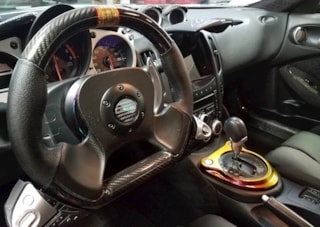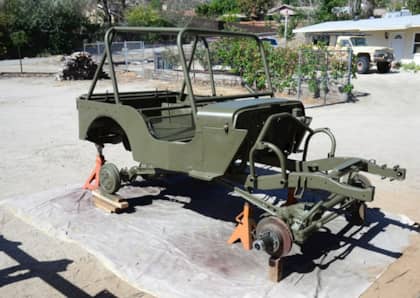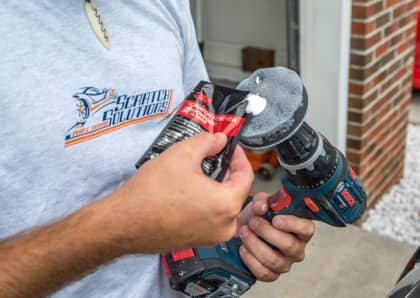How to Repaint Your Car’s Interior
So you just picked up a used ride that you are excited to cruise with but are embarrassed by the interior. Or maybe you are still having a blast with that '90s JDM-swapped Integra you built a decade ago. Either way, chances are some of the interior parts could use a hug. Touching up interior parts and panels is easier (and cheaper) than you may think. The best part is that all of the supplies can usually be found at your local auto parts store for under $40.
For supplies, all that is required is wet/dry sandpaper, acetone or denatured alcohol, primer and/or adhesion promoter, any color and clear coat

Plastics
Most of the parts and trim panels in automotive interiors are some form of plastic. Even the chrome, brushed metal and wood-looking parts are usually plastic, just with a plating or applique. There are multiple types of plastics used in cars, and not all plastics take paint or adhesives the same way, if it at all. That's the critical detail.
On the back of almost every part is a marking that designates the family of plastic the part is made from. Common ones are PP (polypropylene), ABS (Acrylonitrile Butadiene Styrene), PPS (Polyphenylene Sulfide), PA (Nylon or Polyamides) and PVC (Polyvinyl Chloride). There are more, but those are the main ones. For example, Nissan uses PP on over 80 percent of their interiors. The only parts that are ABS are silver, chrome or painted parts.
Plastics do not take paint the same way as metal or fiberglass. Plastics are oil-based, so they tend to need more mechanical bonding rather than chemical bonding. This is why the prep stage is the most important, as each plastic type requires a slightly different approach.
Here is a simple cheat sheet for the prep of each plastic:
| Plastic Type | Instructions |
|---|---|
| ABS textured: | Scuff with 300 grit sandpaper, wipe with acetone |
| ABS smooth: | Scuff with 600 grit, wipe with rubbing alcohol |
| PVC textured: | Scuff with 300 grit, wipe with acetone |
| PVC smooth: | Scuff with 600 grit, wipe with rubbing alcohol |
| PVC soft (soft, squishy parts like the dash or armrest): | Scuff with 400 grit (do not tear the surface), wipe with rubbing alcohol |
| PA smooth: | Scuff with 600 grit, wipe with rubbing alcohol |
| PP and PPS: | Soak with water-based degreaser, scuff with 300 grit, wipe with acetone, wipe with rubbing alcohol |
PP and PPS are very oil saturated. They are considered "self-healing" and low friction parts, which is why they are commonly used for door pulls, sill plates and kick plates. They can be tricky to get paint to stick to. Note that even with proper preparation, the paintjob may not last as long as paint on an ABS part. Parts made of PP especially must be heavily scuffed so the paint has more tooth (surface area) to grip on to.
It is important to note that if a part has been bathed in years of Amour-All, paint may not stick as well (if at all) because that product tends to absorb into the plastic. If the part is shiny, then it isn't clean or scuffed well enough. Acetone will get interior detailers off of the part, but make sure to apply the acetone to the rag, not the part.

Prepping
A good rule of thumb is to soak the parts in a bucket of dish soap. This helps get off the years of finger grease, fast food grease and whatever else is on the parts. Rinse them and let them dry.
Scuffing the parts is usually the mind-numbingly boring part, but it is a very important step. The goal is to get rid of any shine or gloss in order to promote adhesion. Simply scuff the part until it is dull. Be sure to scuff around the edges and a bit of the underside, then wipe the part down with the recommended solution. When in doubt, wash it with dish soap.

Priming
Priming plastic parts is a must. SEM and Dupli-Color both make good primers for plastics. They are typically labeled "Adhesion Promoter." Hold the can about 8-10 inches away and give the parts two wet, even coats. If you get a run in the primer, wait until it is dry, sand it out, then re-prime. Be sure to get primer/promoter on the edges and underside of the part as well.
Note that the color coat needs to be applied within the specified time window. Read the cans!
Painting
Dupli-Color has a vast assortment of colors to choose from, most of which that will work over the adhesion promoter. The cool part is that the cans' spray nozzles are user-friendly fan tips, making it super easy to put down even coats. It is good practice to get paint around the edges and to the underside of the part. This helps minimize paint flaking off of the edge. Again, keep the can 8-10 inches away and sweep even coats. Let the paint flash 5-10 minutes and give it one more coat. Avoid putting a lot of paint down, as this can make the finish have less durability and even hurt the adhesion of the paint to the part.
Clearing
To protect the new paint, the parts should be clear coated. Double check the instructions on the can for the top coat window. It is good practice to lightly wipe the part down with a tack cloth using dabbing motions. As for applying clear, the same rules apply. Keep the can 8-10 inches away and sweep an even two or three coats. Make sure to get clear around the edges and underside.
Once done, avoid the urge to put your shiny "new" parts back in. Painted parts need to cure. Leave the parts alone for a day or two, preferably in sunlight. After the cure period, carefully put the parts back in. If an edge gets chipped, spray a little bit of color into the can's cap and dab the paint into the chip with a paint brush.

Quick Do's and Don'ts
Do wear powderless latex or vinyl gloves when handling the parts. Plastic parts absorb skin oils very easily and that will cause spots or fisheye.
Do use the same brand and product line throughout the steps. If using Dupli-Color for primer, use Dupli-Color for the color and clear.
Don't paint while it is hot or humid out as the paint may not cure properly.
Do take your time cleaning and sanding.
Don't get discouraged if it didn't turn out right. Nine times out of ten you can just sand everything off and try again.
Do treat the parts as if they are exterior parts (quick detailer).
Don't use Armor-All or similar products on the painted parts.
Do get creative by trying different colors or masking patterns. You are only limited by your imagination.
Interior touch-ups are a fun and inexpensive way to refresh your interior, whether it be for your daily driver or your show car, and the the best part is, it's cheap!











